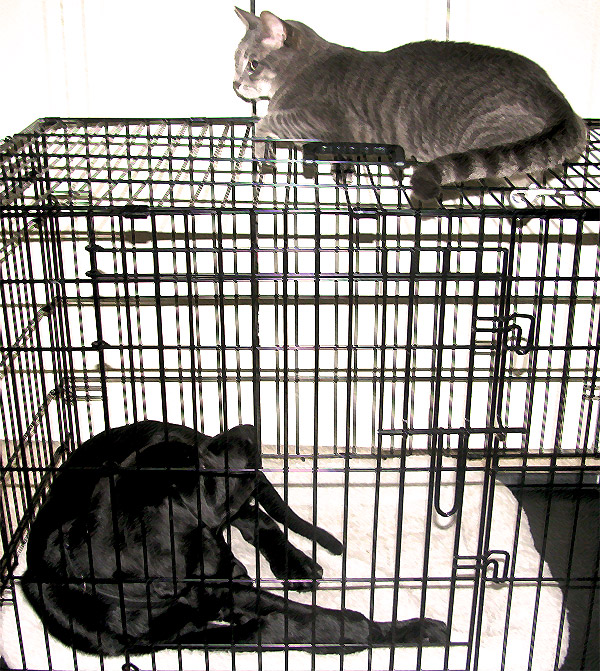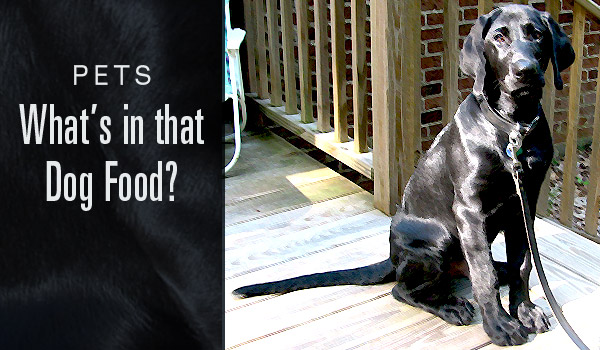Pets: What’s In That Dog Food?
Story and photos by Kaynan Goldberg. Kaynan is CaryCitizen’s 13-year-old columnist on all things frugal, crunchy, healthy and green. She blogs at VeggiesGoCrunch.
Cary, NC – Murphy is my grandfather’s Black Labrador Retriever. He is about ten months old, and he is adorable. But what’s in his food bowl?
A Dog’s Life
Murphy has a good life. He goes the dog park every day. He spends a few hours either jumping off the dock into the lake (remember, he’s a Lab) or running around and just being a dog. When it’s time to head home, he’s ready for dinner, and then sleep. His life is full of people who love him.
Murphy is a lucky dog. My grandfather really thinks about what goes into Murphy’s food bowl, which is more than can be said for most dog owners. I’m not throwing anybody under the bus – I’m just stating a fact. They may think they know what they’re feeding their dogs. But most of them have been brainwashed by advertisements telling them that their brand of dog food is amazing.
If you have a dog, think back to the last time you bought dog food. Did you even bother to look at the ingredients list? If you didn’t, go to your brand’s website and check right now. I’ll wait for you.
… Have you checked yet? No? Go do it.

Ingredients
Alrighty, then. Did your dog’s food have chicken as the first ingredient? Or maybe lamb? Or fish? If so, good for you – and, more importantly, good for your dog! If not, it was probably a corn or soy product. I’m sorry to say that that is bad news. Corn and soy are both inflammatory in dogs.
Now look at the second ingredient. Depending on your brand, this could be anything from “ground rice” to “chicken meal” to “meat by-product meal.” So you know, a lot of the meat in dog food is in “meal” form. All this means is that the meat has been concentrated and dehydrated, so that there is less fat and more protein packed in the food. It’s obviously a process, but it’s one of those things you just can’t avoid, and it’s certainly not the worst thing you could feed your dog.
One thing to think about – the type of meat should always be listed, be it chicken, duck, fish, beef, whatever. If it just says “meat,” then that means the manufacturers don’t want to disclose what kind of animal is in their dog food. It’s like the mystery meat in the cafeteria – nobody wants to eat that. If your second ingredient is another corn or soy product, you’ll probably want to research another brand.
What’s the third ingredient? If you haven’t found an animal protein source yet, you should definitely see one now. If the first two ingredients were animal-sourced, then this third ingredient will probably be a grain – rice or barley.
The fourth ingredient will be another grain, and the fifth will probably be some form of animal fat. Like before, you’ll want to know what kind of animal. It might say “preserved with mixed tocopherols” – that’s okay. Mixed tocopherols are antioxidants that keep the fat from spoiling.
Now, if your dog food was mainly quality meat and whole grains, then you – and, more importantly, your dog – are good to go. However, if you found a bunch of corn, soy, and mystery meat, you might want to look at some other brands. Blue Buffalo, which is what Murphy eats, is an affordable brand with minimal fillers and no artificial stuff. My grandfather swears by it, and I can certainly vouch for it. It may not be the “perfect” dog food, but it is definitely good. (I promise that I am not being paid to advertise Blue Buffalo. I am just a fan of their dog food.)
Really, this whole post was just to get you in the habit of reading ingredients. Maybe you already read the ingredients on your food, or your family’s. If you do, that’s great – keep up the good work! But if you have a dog, it’s part of your family, too. You should definitely treat it that way. It is more expensive, but by investing in quality food, you might be saving yourself a lot of money on vet bills.
Gus Counts Too
 Up next on the pet food frontier: cat food! We do not actually have a dog, although that will hopefully change some time this year, but we do have a cat named Gus.
Up next on the pet food frontier: cat food! We do not actually have a dog, although that will hopefully change some time this year, but we do have a cat named Gus.
Gus is a great cat. He’s sweet, he never bites or scratches, and he even puts up with my baby brother – no easy task, since my brother is a three-year-old who likes to use Gus as a pillow. My whole family loves Gus, and we’d only do good things for him.
Can you guess where this is going? While I was researching this post, I learned something about Gus’s food, Hill’s Science Diet. We’d always thought that it was a good food – it’s got the words “Science” and “Diet” right in the name! Turns out that it’s not that great.
It’s one more thing to think about – and of course I learned this just after we bought Gus a new bag of food.
Kaynan Goldberg with her father Jordan at the Western Wake Farmers Market in Cary. Photo by Hal Goodtree.





My two dogs are just another one of the family. I too was led to believe that a well know brand name or even natural meant something. Using meds to cover up the underlying problem of a bad diet is just crazy. When my pet developed allergies I couldn’t feed him egg, soy, chicken or corn. It was amazing to me how hard it was to buy a quality dog food with out those fillers. Years latter I know know but only because I had to read labels and watch for certain ingredients.
Hi Kaynan! Remember me? Your old neighbor in Fernandina! Anyway, I really enjoyed your article. We also swear by Blue Buffalo. Molly started having terrible skin problems, to the point she was losing hair in clumps. I went to my local PetSmart to buy some fish oils and anything else they would recommend. After talking to an associate, he convinced me that all I would have to do is switch her to Blue Buffalo & I’m glad I did. Her skin cleared up soon after switching her. It provides all of the fish oils & nutrients needed & she eats it better than any other dog food she has had in the past.
We switched our cats to a Wilderness high protein dry foot after our oldest cat was diagnosed with diabetes. I learned that nearly all the dry foods have corn and corn products as the primary ingredient and that is bad for cats (and dogs). Cats are obligate carnivores and only eat grasses or herbaceous vegetation in small amounts. Corn is not something they’ve been designed to digest.
Kaynan-
I buy Pet Pantry food for my dogs. It would make you proud. It fits your nutritional guidelines and it is made locally in Apex (AND they deliver to my door). And it’s cheaper than Science Diet.
Check it out – http://feedyourpets.com/
– Matt
Unfortunately, chicken and other meat / fish meals are more than just dehydrated.
(Dehydration is defined as a more or less gentle drying process of an ingredient; dehydration can be done at a wide temp range; it can be low enough to result in raw foods, but is mostly done at high temperatures resembling baking temperatures; high temps are preferred as they shorten processing times which are more profitable. Unfortunately, only certified organic pet food manufacturers have to disclose their manufacturing processes to an unbiased 3rd party that is accredited to the USDA.)
Before drying any meat or fish meals, meats or fish are *cooked* which allows the removal of fat (this is a problem as always when nutrients are separated from their natural nutrient companions). The isolated fats are then sold separately to achieve any desired fat content of another pet food product (this doesn’t make a lot of sense to me, nutritionally speaking; but it’s profitable because this way AAFCO standards can easily be concocted and sold at a higher price than a real natural (whole!) pet food product).
Kaynan I am guilty of going cheap for my cats- hey afterall they were strays and anything I feed them is better than picking out of a garbage bin. BUT I promise to look at the ingridients next time I’m at the store and try to do better.
I also know my crafty cats do add the occasional protein to their diet with some hunting on their own sssH! Cary has a leash law even for felines!